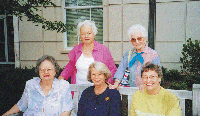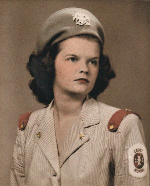Milestones

Five
members of the Class of 1946
visited Emory last June for a reunion.
The longtime friends include (seated
from left), Helen Patten Rainer, Merle Harvey Jensen, and Hazel Cox Wallace.Standing
behindthem are Helen Yarbrough Spruill (left) and Nora Mason Johnson.

![]()
We
didn’t realize until after the war [when nurses who had served overseas
came home] just how much responsibility we had—that we were taking
on the duties of RNs as seniors.
—Merle Harvey Jensen, 46N

Serving
the War Effort at Home
Cadet Nurse Corps students heed the call
This
story is part of a series of historical snapshots of the School of Nursing,
which will celebrate its centennial in 2005.
The country probably hasn’t experienced as exhilarating and patriotic
a celebration as V-J (Victory-Japan) Day during World War II. When President
Truman announced on August 14, 1945,* at 7 PM that Japan had agreed to
surrender unconditionally, Americans rejoiced by dancing, cheering, kissing
(remember that famous photo of the passionate couple on the cover of Life
magazine?), and ringing church bells—for days. One of the longest
and loudest revelries took place in New York City, where a small group
of US Cadet Nurse Corps students from Emory were quietly attending to
their duties in the pediatric ward at Bellevue Hospital.
The dedicated students joined the Corps in late summer 1943. At that time,
Japanese bombs had destroyed much of Pearl Harbor nearly two years earlier,
war had raged in Europe for more than four years, and American patriotism
was running high. Hundreds of young women headed to Emory and other nursing
schools across the nation. Instead of training to heal soldiers wounded
in Europe or the Pacific, these student nurses responded to a health care
crisis of another sort. Nurses were desperately needed on the home front
to immunize children, help deliver babies, assist in operating rooms,
and serve in medical and surgical hospital wards.
Merle Harvey Jensen and Hazel Cox Wallace, both 46N, were among the women
who responded. They joined the Cadet Nurse Corps at Emory, one of more
than 20 US nursing schools with this program. Although both alumnae had
families who were willing to pay for nursing school, the students joined
the three-year program as much for patriotism as desire for a nursing
career. Government compensation for their education didn’t hurt their
decisions either.
More than 179,000 young women ultimately joined the US Cadet Nurse Corps,
which was administered by the US Public Health Service. About 30 women
joined Emory’s first cadet class in 1943. Congress created the program
that year by passing the Bolton Act, the brainchild of junior Congresswoman
Frances Bolton of Ohio. The corps subsidized the students’ education,
including tuition, fees, books, nursing uniforms, and a monthly stipend.
Emory nursing students received a whopping $15 a month.
Jensen lived in a basement-level dorm room with six other girls. They
dubbed it “the wreck” because it lived up to that name. Since
Emory and the country called for lights out at 11 PM, the students often
studied in a storeroom with no windows.
 |
| About 30 women joined Emory’s first US Cadet Nurse Corps class in 1943. Merle Harvey Jensen was among them. She also is pictured above, seated on the bench in the center. |
Grocery staples such
as butter, sugar, and coffee were rationed for the rest of the country,
but the aspiring nurses ate well in the student dining room. Recalls Jensen,
“My mother had ration cards, but I don’t remember any students
needing them.” Wallace remembers walking across campus through the
woods to the shopping strip called Little Emory to buy ginger- ale floats
and doughnuts. “That’s how I used my monthly allowance,”
she says.
While on duty, each student wore a blue-striped uniform with white apron
and Emory nursing cap, along with a blue wool cape on brisk days. Off
duty, students could dress up in their gray-with-red-trim cadet uniforms,
with red epaulet stripes on each shoulder and a dark gray felt beret emblazoned
with a medical insignia. Nursing students loved wearing their uniforms
out on the town, especially on trolley rides from Emory to downtown Atlanta
for shopping.
In August 1945, during the second year of the program, half of the class
boarded a train to New York to begin a three-month pediatric rotation
at Bellevue Hospital. (The other half of the class went at another time).
“New York was a wonderful treat for us,” says Wallace, who was
only 18 at the time. “One of the maternity parents we had treated
at Emory Hospital offered to ask her sister in New York to show us around
the big city. The sister was a model married to the editor-in-chief for
Mademoiselle, but because of the war, he was on assignment in Europe for
the military’s Stars and Stripes.” The woman had a car (something
no student had at the time) and carried the girls to see the ritzy apartments
on Fifth Avenue and to nightclubs such as Three Crowns, 21, and James
Beach. Things got even juicier when Japan surrendered.
“On V-J Day, I was free to go downtown after work,” says Wallace.
“It was a mob scene. Everyone was hugging everyone else. Restaurants
had to close for three days. Since they couldn’t sell the food, they
sent it to us at Bellevue. We ate like queens!”
But New York wasn’t all frolic and fun, notes Wallace. All of the
students worked hard, mostly on night duty. “We’d get the children
up, wash their faces, hands, and feet. One nurse knitted these cute little
caps we gave to the children. Some of us got lice. It was startling to
us. When we got over our embarrassment, we finally went to the infirmary
for treatment.”
Back at Emory, the nursing students lived in Harris Hall, starting in
the basement their first year and moving up a floor each year they were
in the program. By the time they made it to the second floor, the students
already were very experienced nurses.
“We’d take a full load of classes during the day,” says
Jensen. “Registered nurses and Emory professors taught us. We’d
then work the 3-to-11 shift at the hospital.”
Seniors took on a lot of duties, sometimes serving as charge nurse at
night. The supervisor was the only registered nurse on the floor. “That
was the way it was during the war,” Jensen adds. “We didn’t
realize until after the war [when nurses who had served overseas came
home] just how much responsibility we had—that we were taking on
the duties of RNs as seniors.”
The students attended classes year-round, taking only two weeks of vacation
a year, whenever they could get time off. “We worked hard,”
Jensen says. “One time my eyes closed in class, and the professor
offered me a pillow. That woke me up!”
After graduating from nursing school, Jensen and the other cadets were
required to serve for the duration of the war in the US Public Health
Service or the armed services. Since the war had ended, Jensen stayed
at Emory until she was old enough to sit for the state boards and returned
to Florida to practice at Samaritan Hospital, near her home in West Palm
Beach. She married, had three children, and spent the remainder of her
nursing career at Jackson Memorial Hospital in Miami, where she now lives.
Wallace served with the Public Health Service in New Orleans. She later
married, had three children, and became an industrial nurse at Tenneco.
Today, Wallace lives in Houston.
The nurses’ experience at Emory, with few breaks to go home and see
family, brought the women together. They now meet almost every year for
reunions at Emory or in one of the alumna’s home cities. Wallace
planned the first reunion in 1966. Last year, Jensen, together with Margaret
Scott and Nora Mason Johnson, organized a reunion at Emory, which five
classmates attended.
“We’re all really close,” says Jensen. “We formed
incredibly close bonds. We’re all the best of friends.”
—Lee
Jenkins
Lee Jenkins is an Atlanta freelance writer.
*Officially, V-J Day is September 2, 1945, the
day the Japanese signed the terms of surrender aboard the USS Missouri
in Tokyo Bay.